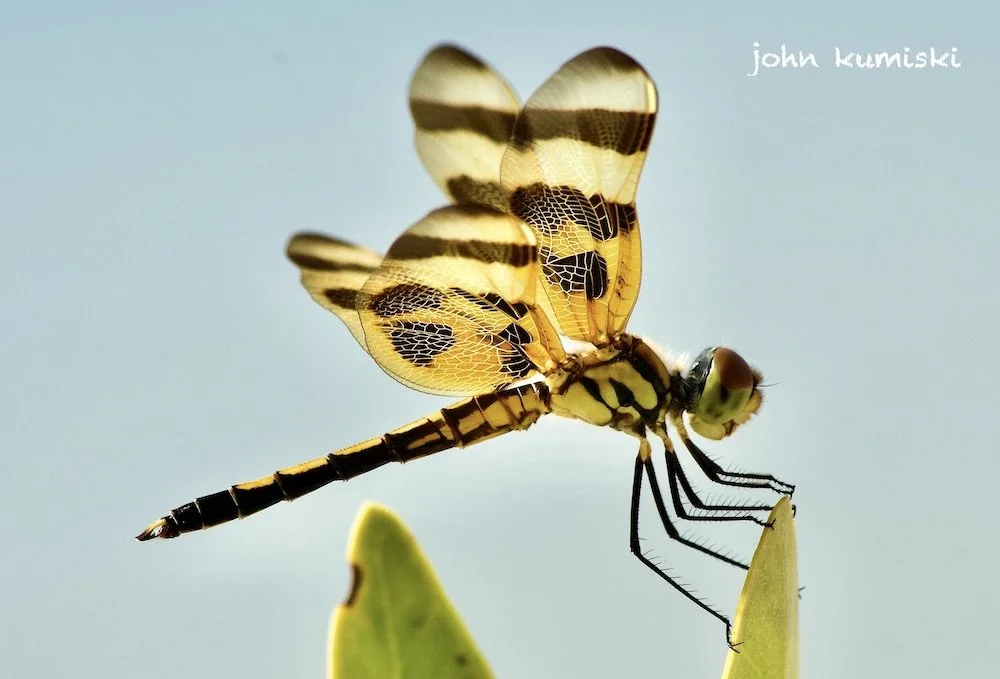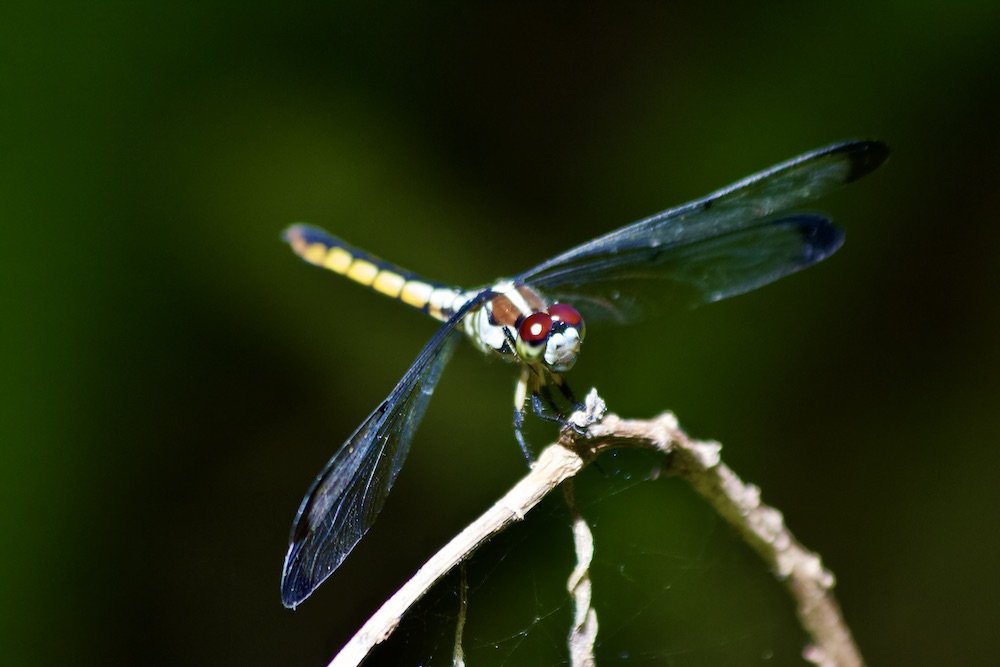Photographing Dragons
By: John Kumiski
Dragonflies were part of my youth. My father was a freshwater fisherman- dragonflies are found around freshwater. I grew up watching their amazing aerial acrobatics.
I learned early on that dragonflies were insects (order Odonata), that they lay their eggs in water, that the immature, aquatic form was quite a ferocious little predator in its own right, that eventually that little predator crawled up out of the water on a bulrush (or whatever) stem, split its skeleton, and, magically, a winged adult came out. The winged adults were likewise voracious predators.
On a canoe trip on Maine's Saco River, about 30 years ago, I swung and missed at a biting mosquito. As I watched it fly off, a dragonfly zoomed up and caught it! It was an incredible thing to see, and I've never seen it again. Obviously, a lack of observation on my part, because an adult dragonfly will eat dozens to hundreds of mosquitos, gnats, and other small flying insects daily. Hooray for dragonflies!
Needham's Skimmer male, Orlando Wetlands Park, FL; Canon EF 100-400mm ƒ4.5-5.6L IS USM, ISO 1000, f13, 1/500 sec.
Needham's Skimmer female, Orlando Wetlands Park, FL; Canon EF 70-300mm ƒ4-5.6 IS USM, ISO 500, f9, 1/500 sec.
My knowledge of dragonflies stood still for quite a long time, by human standards. Earlier this year I was out for a walk, around a pond. I stopped at a picnic table to take some sustenance. While I ate I couldn't help but notice a couple green dragonflies near me, sparring with each other over a tiny piece of turf where both wanted to perch- alone. No perch sharing for these guys. It occurred to me while watching them that not only did I not know what kind of dragonflies they were, I didn't know the name of any specie of dragonflies. Shame on me!
When I got home I did some Googling. The sparring partners I'd seen were Eastern Pondhawks, a common and widely distributed species. They were also both females. Most species of dragonflies exhibit what's called sexual dimorphism. What that means in plainer English is that the males and females don't look alike.
More research ensued. Globally we find 13 families of dragonflies. Six of them are found in my home state of Florida, where over 100 species are found. If I wanted to learn to identify them by sight, I'd have to remember what over 200 different dragonflies look like. Plus, their colors change as they age. Yes, it would be quite a project.
Eastern Pondhawk male, Orlando Wetlands Park, FL; Canon EF 70-300mm ƒ4-5.6 IS USM, ISO 640, f8, 1/500 sec.
Eastern Pondhawk female, Chuluota, FL; Canon EF 100-400mm ƒ4.5-5.6L IS USM, ISO 1000, f6.3, 1/500 sec.
The first dragonflies appeared about 300 million years ago- it's a fantastic design! Fossil dragonflies have been found that had two-foot wingspans. A BIG modern dragonfly is five inches across.
That diminutive size, although large for an insect, is quite small for a camera subject. My first trip to photograph dragonflies was a learning experience.
A dragonfly's head consists of almost exclusively of compound eyes, and mouthparts. Their field of vision is nearly 360 degrees, and they see movement very well. I'd spot one I wanted to photograph, and then try to get close enough to get a decent shot with my 300 mm. zoom. Zoom is what most dragonflies did, too. They'd see me coming, and off they'd go. They are very aware of their surroundings! It was frustrating.
Fortunately, there were lots of dragonflies, so I got lots of chances. And if I stood still, some would land near me, and I'd get a shot. But I also learned that the 300 mm. zoom was barely adequate for what I was trying to do.
I found and purchased a used 400 mm. lens. I also started corresponding with a Ph.D., Dr. Mary Ann Perron, a dragonfly expert. She suggested if I wanted to identify dragonflies, I should get a net and capture them. I could use the guidebook (Paulson's Dragonflies and Damselflies of the East) to identify them, and then let them go. I liked the idea. But. I'm almost 70 years old and have a lung condition. Running after dragonflies, no matter how appealing, wasn't going to happen.
Another thing I learned through photographing, though, is that different types of dragonflies behave differently. Every species has a time window, called a flight, when they are flying around in the adult stage. When the flight of that species ends, you won't see another one until the next flight, next year.
Four-Spotted Pennant male, Orlando Wetlands Park, FL; Canon EF 70-300mm ƒ4-5.6 IS USM, ISO 500, f9 1/500 sec.
Four-Spotted Pennant female, Merritt Island National Wildlife Refuge, FL; Canon EF 70-300mm ƒ4-5.6 IS USM, ISO 500, f10, 1/500 sec
Also, the ones I try to photograph are perchers. Many types of dragonflies seldom perch, though, spending most of their time cruising. Since a dragonfly can hit flight speeds of 20 MPH, I have yet to try to photograph the fliers. It can be done. But I'm gonna master the perchers first. :-)
Finally, there are other beautiful insects in the order Odonata called damselflies. They are beautiful and worthy photo subjects, too!
I used the 400 mm. lens, and got pictures a little more easily, with higher quality. I also found out about a few different websites where you can submit photos of dragonflies, and other folks there will tell you what you've got. Here are three of them-
https://www.odonatacentral.org/#/
https://www.insectidentification.org/dragonflies-and-damselflies.php
https://www.facebook.com/groups/119127804903860/
Dr. Perron also suggested I take a different approach to photographing them. What I do (still) is slowly walk (or paddle, I shoot from the kayak sometimes, which is even harder), looking for perched subjects to shoot. As already explained, they'd usually see me coming and fly off. She said I should use a tripod and focus on the perch. The beast would come back eventually, and I'd be there waiting.
I have not tried that technique. I should, though.
OK, the techies probably want the techie information. I'm using a Canon 60D body. The 300mm. lens is a Canon EF 70-300 f 4-5.6. The 400 mm. lens is a Canon EF 100-400 f 4.5-5.6. Neither of these lenses is very fast, so my ISO is usually at 1000, with a shutter speed of 1/500th. Camera shake is usually not a problem. Best time of day light-wise is near sunrise and sunset. When it's chilly the bugs fly best during the warmest part of the day, though.
I have neither Photoshop nor Lightroom, and just post-process with the Photos program on my Macbook Pro. There's no stacking going on in my images!
Blue Dasher male, Merritt Island National Wildlife Refuge, FL; Canon EF 70-300mm ƒ4-5.6 IS USM, ISO 1000, ƒ8, 1/400 sec.
Blue Dasher female, Merritt Island National Wildlife Refuge, FL; Canon EF 70-300mm ƒ4-5.6 IS USM, ISO 1000, ƒ5.6, 1/500 sec.
What I find while photographing dragonflies (and whatever else catches my eye) is that it's a much more social activity than fishing. There can be loads of people around- the dragonflies don't care!
It's been a great project so far. I've learned a bunch about dragonflies, learned to identify a few by sight, and met some interesting people. I've gotten some fine images. I'll be taking a dragonfly identification class soon, too. Anyone who wants an inexpensive hobby that helps them appreciate the fantastic beauty of Nature can become a dragonfly watcher for the cost of a guidebook and a pair of binoculars. Cameras cost a bit more, but many readers will have one already, anyway.
Long live the dragonfly!
Have you had a great out experience? Join Global Outdoors and write a review to tell everyone about it! We’re building the home for trusted reviews of outdoor experiences, outfitters, and guides.










